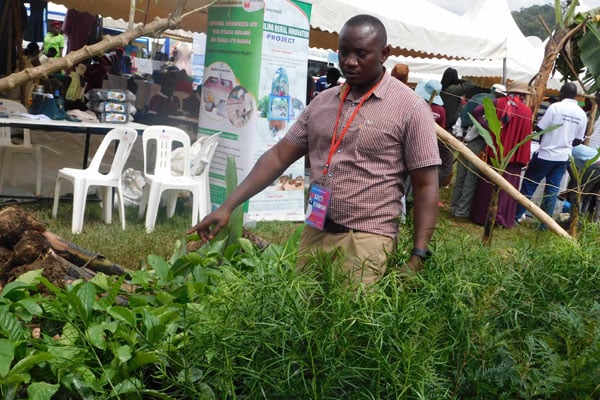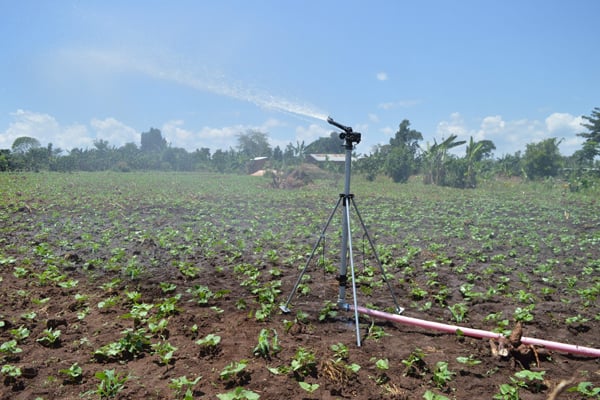Prime
Farm layout: How to plan your farm

Tony Kyambadde points at the Robusta coffee and tree seedlings at their stall during the POWESA Agribusiness Fair recently. Photos/Michael J Ssali
What you need to know:
- The demonstration garden layout was clearly aimed at maximising output and income from a small scale farm besides making farmers fully conscious of natural environment preservation which includes soil conservation practices.
There were some very good farming lessons to learn from the different stalls in the recent Cbs Powesa Agribusiness Fair 2022.
One of the stalls, Caritas, Masaka Diocesan Development Organisation (Maddo) Kitovu, had perhaps the best lessons about farm layout for small-scale farmers generally found in Masaka region and some other parts of Uganda where bananas and coffee are the main farming enterprises.
Tony Kyambadde, project coordinator, Caritas Maddo Kitovu, who was in-charge of the stall at the show was however quick to explain, “Due to the small space we have here at the showground we could not bring all the materials necessary to demonstrate all the specific physical and structural features of a model farming homestead. For example, what we have here does not have any demonstration of livestock keeping which is important for manure production. Yet as you can see there is cow dung all around the base of the banana tree in our demonstration garden. We strongly encourage all farmers to keep livestock.”
Demonstration garden
The demonstration garden layout was clearly aimed at maximising output and income from a small scale farm besides making farmers fully conscious of natural environment preservation which includes soil conservation practices. Mado, a non-governmental organisation (NGO) has been active in community development and poverty alleviation activities for more than 30 years.
Training farmers
The NGO teaches nutrition, hygiene, crop production, livestock keeping, value addition, environment conservation, record keeping, gender equity in farming, and is also involved in provision of vocational skills to the youth.
At the show Maddo displayed well grown Robusta coffee seedlings and seedlings for Podo and Grevillea trees. They also demonstrated well developed and disease free banana suckers.
Show goers learnt that Maddo has seedlings of other types of trees, mainly fruit trees, which were not available at the show. “As a non-profit organisation we do not sell the tree seedlings but we supply them to the farmers as part of our tree planting campaign,” says Kyambadde. “We however lay more emphasis on planting of indigenous trees.”
Best practices
Along the edges of the demonstration garden were planted some tree seedlings. According to Kyambadde this was supposed to indicate to the show goers that farmers should plant trees to demarcate their land.
“They also serve as wind breakers and can be very helpful during incidents of rain storms,” says Kyambadde.

Dairy cattle feed on a farm.
Trees planted along garden edges reduce the risk of wind soil erosion too. He however advises that the trees ought to be well spaced depending on the type of the farming enterprise but a distance of 20 feet between the trees is recommended. Kyambadde says farmers may trim the trees and use the branches for firewood. The leaves from trees such as mangos and mutuba are good fodder for goats, cattle and sheep.
Intercropping
The enterprises in the demonstration garden were banana, as the main crop, Robusta coffee as the secondary crop, and apiary as the third activity. He advises intercropping as the best way to go and explained that when the farmer’s main enterprise crop is bananas the spacing between the crops should be about 10 feet by 10 feet and the coffee should be planted 20 by 20 feet. However if the main enterprise is coffee then spacing between the coffee trees should be 10 by 10 feet while that of bananas should be 20 by 20 feet.
Beehives
Kyambadde says crop farmers are strongly encouraged to keep bees not only because honey is a good source of income but also because bees are pollinators and play a key role in crop production. The advantage with carrying out different enterprises on the farm is that if one enterprise does not earn a profit sometimes the others may do so.
Mulching
The entire garden was well mulched with grass which serves to keep the soil moist and to mitigate soil loss by erosion arising out of wind and runoff. Show goers were able to see how mulching in a banana garden ought to be carried out.
“The grass should not extend too close to the banana tree stem to discourage multiplication of banana weevils,” Kyambadde explains. “Not even should soil be heaped around the banana stem as this would render the stem bare and susceptible to felling of the banana tree by strong wind.”

Kyambadde (wearing a tag) points to the charcoal briquettes made out of biodegradable gabbage.
Importance of cattle on your farm
In the demonstration garden there was free space meant for easy passage and movement by the farmer doing farm inspection or carrying inputs. For sloppy areas, part of the space may be used for construction of contour bunds. Along the passages and the garden edges farmers are encouraged to plant fodder grass for feeding livestock. “If you can see bits of cow dung at the foot of the banana tree in the demonstration garden it should be understood that the farmer keeps livestock as well,” says Kyambadde. “We strongly encourage farmers to keep livestock because they are a good source of organic manure.” Maddo routinely gives out Frisian cows to farmers in Masaka Disease for zero grazing after giving them training in cattle keeping. The farmers sell the milk to Maddo which turns it into yoghurt, butter and pasteurized milk among other products. The farmers use the cow dung and urine as manure to boost crop production. In many homes people use biogas for cooking and lighting due to the availability of cow dung.
Household income
It was clear by the demonstration garden layout that Maddo is not only working to promote household incomes for farmers but also to improve nutrition and health. A household which grows food crops and keeps chicken and cows or goats has a greater chance of feeding its members on animal food products such as meat, milk, and eggs. The household also can use clean energy for cooking and lighting with minimal need to cut down trees for firewood.
Innovation
The Caritas Maddo stall also had a demonstration of how to make charcoal briquettes for cooking as a way of reducing firewood dependency and forest destruction. “This begins with waste collection,” says Kyambadde. “At the rubbish collection place there should be a container for plastic materials, a container for metallic and glass objects, and a container for bio-degradable objects.”
Kyambadde says when waste materials are sorted they can be sold while the bio-degradable ones can be turned into charcoal briquettes. There was a machine at the show used to make charcoal briquettes.
“If the farmer has some tree leaves continually falling in his compound or some weeds growing there, they can be collected for briquette making. Show goers were told where to purchase the various equipment for making briquettes, and how much it costs,” says Kyambadde.




